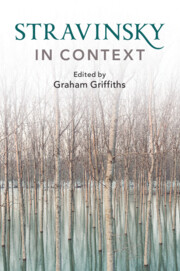Book contents
- Stravinsky in Context
- Composers in Context
- Stravinsky in Context
- Copyright page
- Contents
- Illustrations
- Contributors
- Preface
- Abbreviations
- Frontispiece
- Epigraph
- Part I Russia and Identity
- Part II Stravinsky and Europe
- Chapter 7 Sergei Diaghilev and Stravinsky: From World of Art to Ballets Russes
- Chapter 8 Paris and the Belle Époque
- Chapter 9 Paris, Art Deco and the Spirit of Apollo
- Chapter 10 Stravinsky’s Spain: Fan or Mirror?
- Chapter 11 ‘It is Venice that he loves’
- Part III Partnerships and Authorship
- Part IV Performance and Performers
- Part V Aesthetics and Politics
- Part VI Reception and Legacy
- Recommendations for Further Reading and Research
- Index
- Endmatter
Chapter 7 - Sergei Diaghilev and Stravinsky: From World of Art to Ballets Russes
from Part II - Stravinsky and Europe
Published online by Cambridge University Press: 03 December 2020
- Stravinsky in Context
- Composers in Context
- Stravinsky in Context
- Copyright page
- Contents
- Illustrations
- Contributors
- Preface
- Abbreviations
- Frontispiece
- Epigraph
- Part I Russia and Identity
- Part II Stravinsky and Europe
- Chapter 7 Sergei Diaghilev and Stravinsky: From World of Art to Ballets Russes
- Chapter 8 Paris and the Belle Époque
- Chapter 9 Paris, Art Deco and the Spirit of Apollo
- Chapter 10 Stravinsky’s Spain: Fan or Mirror?
- Chapter 11 ‘It is Venice that he loves’
- Part III Partnerships and Authorship
- Part IV Performance and Performers
- Part V Aesthetics and Politics
- Part VI Reception and Legacy
- Recommendations for Further Reading and Research
- Index
- Endmatter
Summary
Born at the twilight of imperial Russia, Igor Stravinsky inevitably partook of its cultural conventions and rituals, moving closely with particular individuals, associations and vogues in what Alexandre Benois called ‘that hysterical and spiritually tormented time’.1 Among Stravinsky’s many connections in St Petersburg, for example, was the group of artists, writers and musicians known as the World of Art (Mir iskusstva) which, undoubtedly, played a formative role in his musical career.2 True, some observers are hesitant to accept the proximity, finding that ‘there is no real evidence that [Stravinsky] paid attention to the journal [Mir iskusstva] at that time or hankered after any particular association with its authors’.3 On the other hand, Stravinsky’s long friendship and professional liaison with the leaders of the World of Art (Léon Bakst, Alexandre Benois, Sergei Diaghilev, Nicholas Roerich), his intense collaboration with Roerich on The Rite of Spring at Talashkino (the estate of Princess Maria Tenisheva, primary financier of the World of Art journal)4 and his close alliance with the Ballets Russes – which, in many ways, was the extension of the aesthetic platform of the World of Art – would seem to furnish evidence that Stravinsky did, indeed, appreciate the cultural consistency of the World of Art.
- Type
- Chapter
- Information
- Stravinsky in Context , pp. 61 - 70Publisher: Cambridge University PressPrint publication year: 2020

